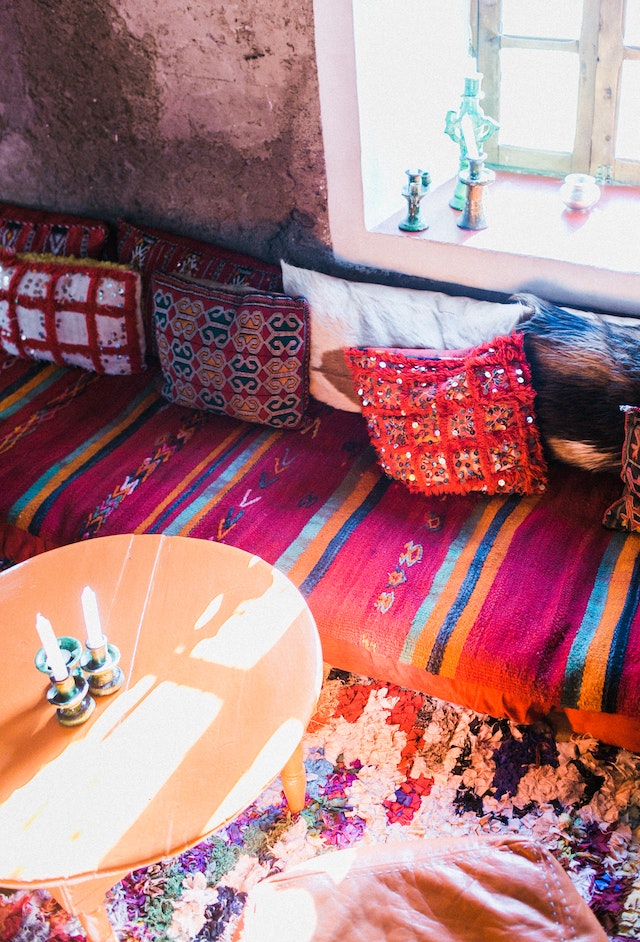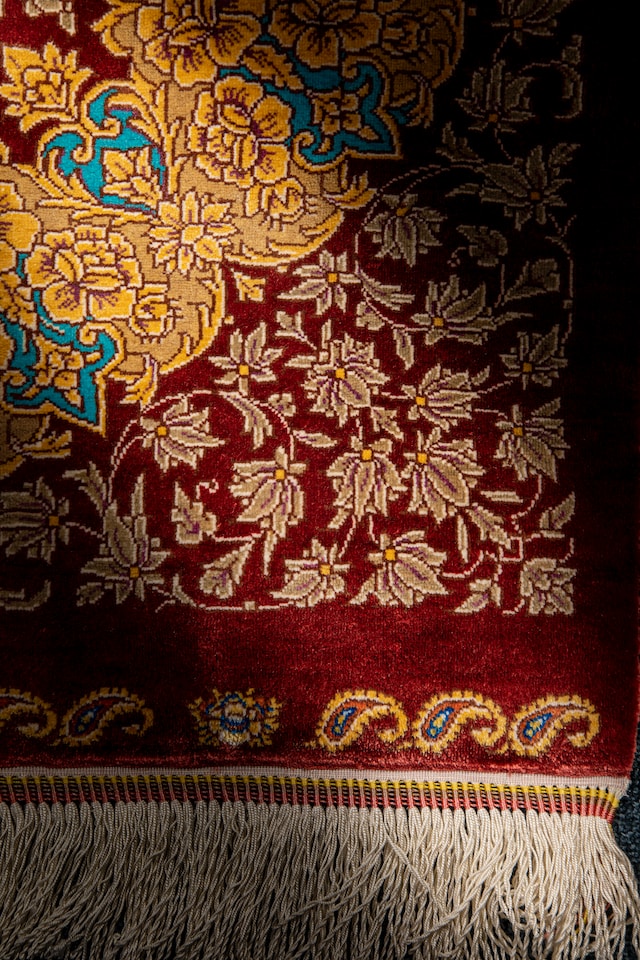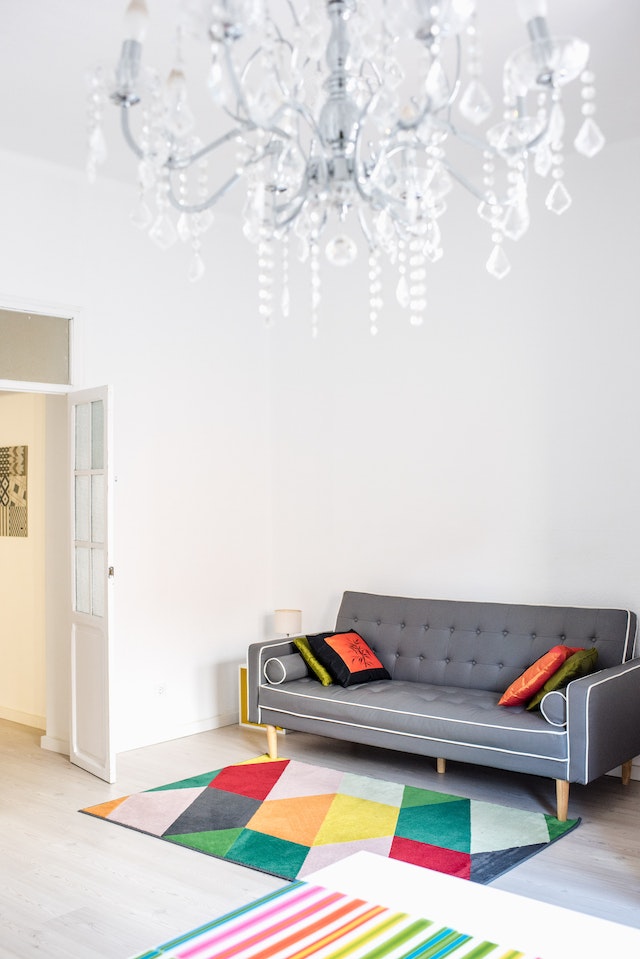

Introduction to Tribal Patterns is a fascinating topic. It has been used in decor for centuries, and it adds an element of uniqueness and style. Not only can tribal patterns bring vibrancy to any room, but they're also (very) chic and timeless. It's no surprise that these designs continue to remain popular!
The most common tribal patterns are African inspired, featuring bold geometric shapes such as chevrons, diamonds, triangles and zig-zags. African tribesmen have always used these shapes in their artwork, from body adornments to murals and fabrics. Additionally, some American Indian tribes also incorporate similar symbols into their traditional art forms.
Moreover, tribal patterns can take many forms; from subtle hints of color on textiles and pottery to more eye-catching designs on furniture or rugs. Depending on the application of the design - whether it be embroidered on clothing or painted onto walls - the pattern can appear more abstract or more representational. When selecting a particular pattern for your home decor, consider its colors and scale so as not to overwhelm the space!
It's easy to see why tribal patterns evoke a sense of adventure and exploration! With so many variations available today, there's sure to be something out there that speaks personally to you. Whether you select one piece with an intricate pattern or create an entire room using these motifs – it'll definitely add a unique touch of style!
Tribal patterns have been a part of decor for centuries, and their history is fascinating! It's believed that they originated in the Middle East, dating back to (at least) 6000 BCE. They were often used as symbols to represent certain values or ideas, like strength and protection. Interestingly, these same symbols were also found in other parts of the world around the same time.
Furthermore, over the centuries tribal patterns came to be associated with various cultures and civilizations. For example, Ancient Greeks used them on pottery and coins, while African tribes would use them in art and clothing. Even today they can be seen as tattoos or paintings on people from many different backgrounds!
Despite this long history of tribal patterns being used across cultures, it wasn't until recently that they began to gain wide-spread popularity in home decorating. This has largely been due to the influence of modern design trends such as minimalism or bohemian style - which incorporate elements from other cultures into their designs. As a result of this trend, tribal patterns are now being used by interior designers across all kinds of homes - from small apartments to large mansions!
It's clear that tribal patterns have had an impact on decor for thousands of years - but never before have we seen them incorporated so widely into everyday life! From jewelry to wallpapers and furniture; it seems you can find these iconic designs anywhere you look. And with more people becoming aware of their cultural significance - it's safe to say that they'll likely remain popular for many years (and maybe even centuries!) to come! Indeed, there's no denying the power that these unique designs hold - proving once again why history is so important in understanding our present day lives!
Tribal patterns in decor have become increasingly popular over the years! They add a unique, cultural element to any space and can be used to express a variety of styles. There are many different types of tribal patterns out there, each with its own set of distinctive characteristics.
For instance, African tribes often produce bold geometric designs which represent different aspects of their culture. These colorful patterns typically feature shapes such as circles, squares or triangles. African motifs can be found on fabrics used for clothing and home furnishings alike.
Moreover, Native American tribes frequently use symbols which depict animals like birds or fish. These symbols symbolize important concepts such as balance, harmony and strength. Additionally, they may tell stories about the tribe's history or beliefs. This type of artwork is commonly seen on jewelry items or wall hangings in homes today!
Finally, Asian cultures tend to favor floral motifs which are usually intricately detailed due to their strong emphasis on craftsmanship and attention to detail. Commonly seen on rugs and drapery items these patterns look stunning when placed together in an arrangement that creates a unified theme throughout the room! Both the colors used as well as the shapes featured often vary significantly between styles from different regions within Asia itself making them truly unique!
Overall, tribal patterns offer a great way to add some visual interest to any space while also serving as a reminder of the artistry and beauty created by cultures around the world! (These) designs are sure to provide both vibrancy and individuality wherever they're employed - making them an excellent choice for anyone looking for something special in their decorating scheme!


Tribal patterns are a common form of decoration in many parts of the world! The role of geography in these designs can be seen in many different ways. Geography affects the types (and colors) of materials available to those creating the patterns, as well as cultural influences and environmental conditions. For example, certain regions may have access to more vibrant hues than others due to their location or resources. Meanwhile, various climates may affect how durable certain designs are over time.
Moreover, geography can also determine what sorts of motifs are used in tribal patterns. Certain symbols or animals that represent a particular region's history or folklore often find their way into the designs. Additionally, variations on traditional motifs may also appear depending on where it is being made; this could range from slight tweaks to completely new images altogether!
In addition, geographical boundaries can play an important role in defining tribal patterns' overall look and feel. Regions with distinct borders – such as mountains, rivers, and other natural features – can create distinct styles for each area they encompass. For instance, one group may use bright blues while another might opt for earthy greens; this provides a variety of looks within even small distances!
Finally, regional customs can heavily influence how people use tribal pattern decoratively. People living close by tend to share similar values and beliefs; thus they often draw upon similar design elements when making art or objects with decorative touches like tribal patterns. Additionally, using specific materials in particular ways is often a signifier of belonging to a certain place or tribe – something that further ties together geography and decoration!
Overall, geography plays an integral role in shaping how we use tribal patterns for decoration around the globe. From determining which colors and materials are available to influencing which motifs appear in the designs themselves – not to mention dictating regional customs - there no doubt exists a strong relationship between geographic factors and our choices when it comes embellishing our surroundings with beautiful tribal pattern decor!
Tribal patterns are gaining (popularity and use) today in decor more than ever! They have been around for centuries, but recently they have become a popular way to add some unique flair to any room. Not only do these patterns provide an eye-catching aesthetic, they can also bring a sense of warmth and comfort to a space.
However, it is important to note that tribal patterns don’t always fit in with every decor style. If you want to incorporate them into your own home or office, it’s best to consider the overall look you want first and then select a pattern accordingly. You should also bear in mind that if you choose too many bold colors or intricate designs, it may end up overwhelming the room.
Moreover, when selecting tribal patterns for decor purposes, be sure to pay attention to cultural signifiicance as well. As these designs often hold special meaning for certain cultures, make sure not to disrespect any traditions by using them incorrectly or without permission.
In conclusion, while tribal patterns can be used effectively in decor if done right, one must exercise caution with their selection and usage! Above all else, respect for cultural heritage should take precedence when incorporating these elements into your living spaces.(Therefore,) Incorporating tribal patterns into your home can be very rewarding if done carefully and thoughtfully!

Tribal patterns in decor have been greatly affected by cultural interactions. (In fact,) their evolution has taken many interesting turns over the centuries! It's undeniable that these exchanges of ideas and motifs have had a strong impact on tribal designs. Through contact with other cultures, tribes have been able to incorporate their own unique aesthetic into new forms of ornamentation. For instance, many African tribes used geometric shapes to create elaborate patterns for adorning their homes or clothing. But when they encountered colonialists from Europe, they began to combine these shapes with colors and symbols from the European tradition - thus resulting in an entirely novel style of decoration!
However, while it is true that cultural interaction has played a huge role in shaping tribal patterns, it's important to recognize that this isn't always a positive influence. In some cases, outside influences can lead to the erosion of traditional designs and practices. For example, traders may bring foreign materials like cloth or beads which indigenous people find attractive and begin using for decoration instead of local resources which are more sustainable. This could lead to a decline in traditional crafts such as weaving or beadwork - ultimately causing them to vanish altogether!
Overall, there is no doubt that cultural interactions have had an enormous impact on tribal patterns in decor. By bringing together different traditions and techniques, these exchanges enable us to explore new possibilities for design - both aesthetically pleasing and culturally enriching! Yet at the same time, we must remember that this process can also be damaging if not managed responsibly; therefore it's important for us all to be mindful of how our actions affect others around us.(Afterall,) it is only through understanding and respect for each other’s ways that we can truly benefit from our shared diversity!
Preservation efforts for traditional tribal patterns in decor have been a long-standing issue. For decades, tribes have struggled to protect their art and culture from assimilation into popular mainstream trends. Despite these attempts, many of the designs that have served as symbols of pride among indigenous people are now found on products from mass-producers.
Yet, there is still hope! Tribes are continuing to fight for the preservation of their unique designs by investing in education and legal protection (such as copyright laws). They are also working to create avenues that enable them to reach new audiences without sacrificing their core values. This includes collaborations with other artists and designers, allowing them to express themselves through art while simultaneously protecting their cultural heritage.
In addition, some tribes have even worked toward the development of their own fashion lines. This has been proven an effective way to both preserve tribal patterns and make them accessible to a wider audience. The creations feature everything from jewelry and accessories to clothing items – all done with respect for the original design elements of each tribe's pattern!
Finally, technology has provided another avenue for supporting tribal patterns in decor. Social media platforms such as Instagram provide an excellent opportunity for showcasing traditional designs while connecting with potential customers who appreciate authentic expressions of cultural heritage. Moreover, websites like Etsy allow crafters and small businesses sell handmade items featuring tribal motifs without having to comply with large companies' rules or regulations.
Truly, there are so many ways we can support tribal patterns in decor! From legal protections and educational initiatives to fashion lines and social media campaigns – it's clear that there are endless possibilities when it comes to preserving traditional designs while also making them more accessible than ever before!
Tribal pattern decor is the use of patterns and designs inspired by tribal art, culture, and artifacts in interior design.
Tribal pattern decor can be found in a variety of home goods stores, online retailers, and specialty stores that specialize in ethnic decor items.
Incorporating tribal patterns into existing decor can be done through rugs, curtains, pillows or other textiles featuring tribal designs; artwork, sculptures or accessories with similar motifs; or even furniture pieces featuring traditional tribal carvings and shapes.
Colors typically used for tribal pattern decor include earthy tones like browns, reds, oranges, yellows and greens as well as blue-greens and purples to represent water sources. Bright colors such as pink or turquoise may also be added to provide a modern twist on the look.
Yes! When incorporating tribal pattern decor into your space it’s important to keep the overall look balanced by pairing bolder elements with simpler ones; mixing different shapes and textures; ensuring the size of each item works within the scale of your room; and adding pops of color to tie everything together.